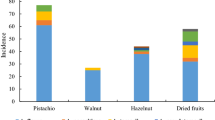Abstract
Two hundred strains of the Aspergillus flavus group isolated from groundnuts (peanuts) growing in Israel were examined for their ability to produce mycotoxins in potato dextrose (PD) broth. Almost 77% of the isolates produced aflatoxin; aflatoxins B1 and B2 were formed by most of the isolates. Simultaneous production of aflatoxins of groups B and G was detected in only 0.5% of the isolates. Microscopic examination revealed that 98% of the isolates wereA. flavus and only 2%A. parasiticus. Cyclopiazonic acid (CPA) was detected in 22.5% of the isolates, including 3.5% that produced only CPA. Sterigmatocystin was detected in only 2% of the isolates and only one isolate produced aflatoxin simultaneously with CPA and sterigmatocysin. The dry weight (DW) of mycelium, 7 days after inoculating the medium, was between 71–110 mg/30 ml medium in more than 70% of the isolates. A general decrease in the pH was observed and 75% of the isolates reduced the pH to 4.5 or below. After 14 days, a small increase in DW and an increase in the pH toward neutrality was observed. On PD agar, 30% of the isolates produced sclerotia, including 5% that produced them profusely. No correlation between mycelial growth, changes in pH of the medium, sclerotium formation, and aflatoxin accumulation could be observed. The mycotoxigenic potential of theA. flavus strains isolated from groundnuts seems to be relatively high and may present a potential threat to human and animal health.
Similar content being viewed by others
References
CAST (Council Agricultural Science Technology) Mycotoxins: Economic and health risks. Ames, IA: Report 116, 1989: 92 pp.
Davis ND, Diener UL. Some characteristics of toxigenic and non-toxigenic isolates ofAspergillus flavus andAspergillus parasiticus, In: Diener UL, Asquith RL, Dickens JW, eds. Aflatoxin andAspergillus flavus in corn. Southern Coop Ser Bull, Alabama Agric Exp Sta 1983; 279: 1–5.
Diener UL, Cole RJ, Sanders TH, Payne GA, Lee LS, Klich MA. Epidemiology of aflatoxin formation byAspergillus flavus. Ann Rev Phytopathol 1987; 25: 249–70.
Gallagher RT, Richard JL, Stahr HM, Cole RJ. Cyclopiazonic acid production by aflatoxigenic and non-aflatoxigenic strains ofAspergillus flavus. Mycopathologia 1978; 66: 31–6.
Luk KC, Kobbe B, Townsend JM. Production of cyclopiazonic acid byAspergillus flavus Link. Appl Environ Microbiol 1977; 33: 211–12.
Vesonder RF, Horn BW. Sterigmatocystin in dairy cattle feed contaminated withAspergillus versicolor. Appl Environ Microbiol 1985; 49: 234–5.
Joffe AZ. Aflatoxin produced by 1,626 isolates ofAspergillus flavus from groundnut kernels and soils in Israel. Nature 1969; 221: 492.
Chu FS, Fan TSL, Zhang GS, Xu YC, Faust S, McMahon PL. Improved enzyme-linked immunosorbent assay for aflatoxin B1 in agricultural commodities. J Assoc Off Anal Chem 1987; 70: 854–7.
Trucksess MW, Mislivec PB, Young K, Bruce VR, Page SW. Cyclopiazonic acid production by cultures ofAspergillus andPenicillium species isolated from dried beans, corn meal, macaroni, and pecans. J Assoc Off Chem 1987; 70: 123–6.
Lansden JA, Davidson JI. Occurrence of cyclopiazonic acid in peanuts. Appl Environ Microbiol 1983; 45: 766–9.
Klich MA, Pitt JI. Differentiation ofAspergillus flavus fromA. parasiticus and other closely related species. Trans Br Mycol Soc 1988; 91: 99–108.
Schroeder HW, Boller RA. Aflatoxin production of species and strains of theAspergillus flavus group isolated from field crops. Appl Microbiol 1973; 25: 885–9.
Doupnik Jr B. Aflatoxin production by isolates within theAspergillus flavus group obtained from farmers' stock peanuts (abstract). Phytopathology 1969; 59: 1024.
Luchese RH, Harrigan WF. Growth of, and aflatoxin production byAspergillus parasiticus when in the presence of eitherLactococcus lactis or lactic acid and at different initial pH values. J Appl Bacteriol 1990; 69: 512–19.
Mehan VK, McDonald D, Haravu LJ, Jayanthi S. The groundnut aflatoxin problem-review and literature database. ICRISAT (India), 1991: 388 pp.
Lee YJ, Hagler Jr WM. Aflatoxin and cyclopiazonic production byAspergillus flavus isolated from contaminated maize. J Food Sci 1991; 56: 871–2.
Pandey H, Saxena J, Pande N, Pande SK, Mehrotra BS. Screening of various substrates for the mycotoxin producing potential ofAspergillus flavus andA. parasiticus. Indian Phytopathol 1989; 42: 132–6 (Abst., Rev Pl Pathol, no. 7168, 1991).
Schroeder HW, Kelton WH. Production of sterigmatocystin by some species of the genusAspergillus and its toxicity to chicken embryos. Appl Microbiol 1975; 30: 589–91.
Wei RD, Lee SS. Stability of aflatoxin B1 in aqueous solutions. J Chinese Chem Soc, Ser II 1969; 16: 174–83.
Horn BW, Wicklow DT. Factors influencing the inhibition of aflatoxin production in corn byAspergillus niger. Can J Microbiol 1983; 29: 1087–91.
Cotty PJ. Aflatoxin and sclerotial production byAspergillus flavus: Influence of pH. Phytopathology 1988; 78: 1250–3.
El-Gazzar FE, Rusul G, Marth EH. Growth and aflatoxin production byAspergillus parasiticus NRRL 2999 in the presence of lactic acid and at different initial pH values. J Food Prot 1987; 50: 940–4.
Joffe AZ, Lisker N. Effects of light, temperature, and pH value on aflatoxin production in vitro. Appl Microbiol 1969; 18: 517–18.
Bayman P, Cotty PJ. Triadimenol stimulates aflatoxin production byAspergillus flavus in vitro. Mycological Res 1990; 94: 1023–5.
Huynh VL, Lloyd AB. Synthesis and degradation of aflatoxins byAspergillus parasiticus, I: Synthesis of aflatoxin B1 by young mycelium and its subsequent degradation in aging mycelium. Aust J Biol Sci 1984; 37: 37–40.
Bennett JW, Horowitz PC, Lee LS. Production of sclerotia by aflatoxigenic and nonaflatoxigenic strains ofAspergillus flavus andA. parasiticus. Mycologia 1979; 71: 415–22.
Wicklow DT. Taxonomic features and ecological significance of sclerotia. In: Diener UL, Asquith RL, Dickens JW, eds. Aflatoxin andAspergillus flavus in corn. Southern Coop Ser Bull, Agric Exp sta 1983: 279.
Author information
Authors and Affiliations
Additional information
Contribution from the Agricultural Research Organization, The Volcani Center, Bet Dagan 50250, Israel. No. 3559-E.
Rights and permissions
About this article
Cite this article
Lisker, N., Michaeli, R. & Frank, Z.R. Mycotoxigenic potential ofAspergillus flavus strains isolated from groundnuts growing in Israel. Mycopathologia 122, 177–183 (1993). https://doi.org/10.1007/BF01103479
Received:
Accepted:
Issue Date:
DOI: https://doi.org/10.1007/BF01103479




